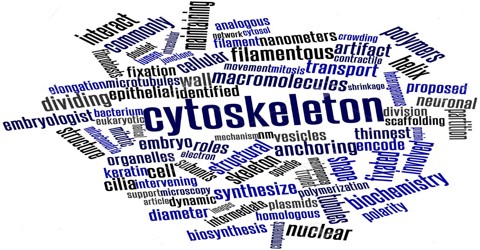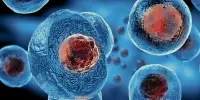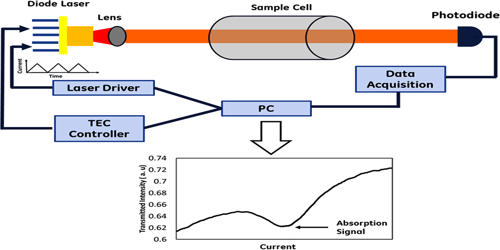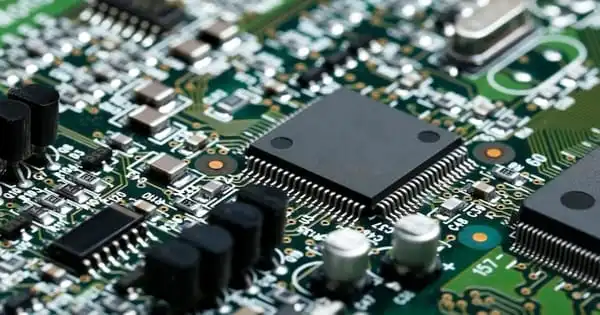Cytoskeleton
Definition
Cytoskeleton is an organelle that forms a lattice or internal framework of a cell. It is composed of protein filaments and microtubules. It extends throughout the cytosol, from the nucleus to the plasma membrane. Its primary function is associated with cell shape, division, differentiation, intracellular organization, and cell movement. It occurs in all cells of living things, particularly archaea, bacteria, and eukaryotes.
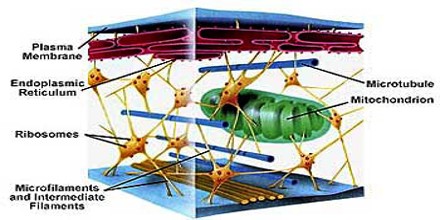
The cytoskeletal systems of different organisms are composed of similar proteins. In eukaryotes, the cytoskeletal matrix is a dynamic structure composed of three main proteins, which are capable of rapid growth or disassembly dependent on the cell’s requirements at a certain period of time. The structure, function and dynamic behaviour of the cytoskeleton can be very different, depending on organism and cell type. Even within one cell the cytoskeleton can change through association with other proteins and the previous history of the network.
The cytoskeletons of eukaryotic cells are of three types: Microfilaments (double helix polymers of actin sub-units, with diameter of 7 nm), Microtubules (polymers of tubulin sub-units, with diameter of 25 nm), and Intermediate Filaments (polymers comprised of two anti-parallel helices or dimers of varying protein sub-units with diameters ranging from 8 to 12 nm, e.g. vimentin (mesenchyme), glial fibrillary acidic protein (glial cells), neurofilament proteins (neuronal processes), keratins (epithelial cells), and nuclear lamins.
Structure and Function of Cytoskeleton
Cytoskeleton is a network of fibers that forms the “infrastructure” of eukaryotic cells, prokaryotic cells, and archaeans. In eukaryotic cells, these fibers consist of a complex mesh of protein filaments and motor proteins that aid in cell movement and stabilize the cell. The cytoskeleton is composed of at least three different types of fibers: microtubules, microfilaments, and intermediate filaments.
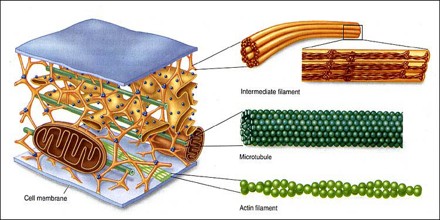
These fibers are distinguished by their size with microtubules being the thickest and microfilaments being the thinnest.
Microfilaments –
Of the three types of protein fibers in the cytoskeleton, microfilaments are the narrowest. They have a diameter of about 7 nm and are made up of many linked monomers of a protein called actin, combined in a structure that resembles a double helix. Because they are made of actin monomers, microfilaments are also known as actin filaments. Actin filaments have directionality, meaning that they have two structurally different ends. These have a number of important roles in the cell. For one, they serve as tracks for the movement of a motor protein called myosin, which can also form filaments. Because its relationship to myosin, actin is involved in many cellular events requiring motion.
Actin filaments play key structural roles in the cell. In most animal cells, a network of actin filaments is found in the region of cytoplasm at the very edge of the cell. This network, which is linked to the plasma membrane by special connector proteins, gives the cell shape and structure
Microtubules –
Despite the “micro” in their name, microtubules are the largest of the three types of cytoskeletal fibers, with a diameter of about 25 nm. A microtubule is made up of tubulin proteins arranged to form a hollow, straw-like tube, and each tubulin protein consists of two subunits, α-tubulin and β-tubulin.
Microtubules, like actin filaments, are dynamic structures: they can grow and shrink quickly by the addition or removal of tubulin proteins. Also similar to actin filaments, microtubules have directionality, meaning that they have two ends that are structurally different from one another. In a cell, microtubules play an important structural role, helping the cell resist compression forces.
Intermediate Filaments –
Intermediate filaments are a type of cytoskeletal element made of multiple strands of fibrous proteins wound together. As their name suggests, intermediate filaments have an average diameter of 8 to 10 nm, in between that of microfilaments and microtubules.
Intermediate filaments come in a number of different varieties, each one made up of a different type of protein. One protein that forms intermediate filaments is keratin, a fibrous protein found in hair, nails, and skin.
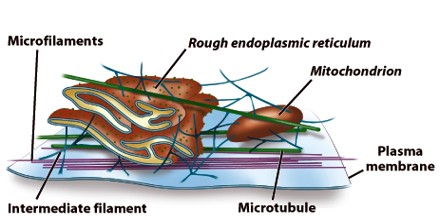
The cytoskeleton extends throughout the cell’s cytoplasm and provides a number of important functions.
- It helps the cell maintain its shape and gives support to the cell.
- A variety of cellular organelles are held in place by the cytoskeleton.
- It assists in the formation of vacuoles.
- The cytoskeleton is not a static structure, but is able to disassemble and reassemble its parts in order to enable internal and overall cell mobility. Types of intracellular movement supported by the cytoskeleton include transportation of vesicles into and out of a cell, chromosome manipulation during mitosis and meiosis, and organelle migration. The cytoskeleton makes cell migration possible as cell motility is needed for tissue construction and repair, cytokinesis in the formation of daughter cells, and in immune cell responses to germs.
- The cytoskeleton assists in the transportation of communication signals between cells.
- It forms cellular appendage-like protrusions, such as cili and flagella, in some cells.
